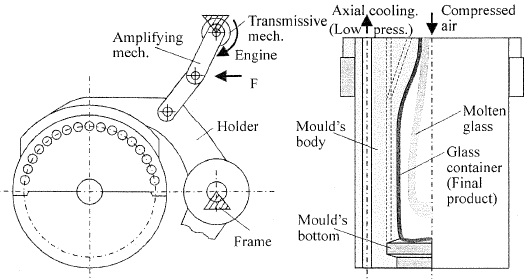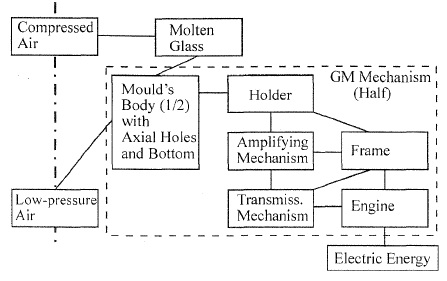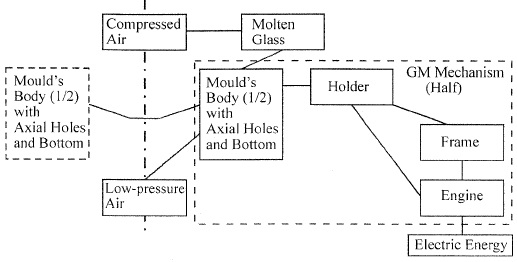Introduction
Fundamental postulate of the TRIZ method is the existence of relatively independent processes of new technical systems formation according to a man's will [Altshuller).
Technical Evolution is a historical process within the framework of human evolution. Even though subjective actions of people are not always in accordance with objective Laws of the process of Technical Evolution, only those results of these human actions survive that are in accordance with existing laws. It is obvious that knowledge of the Laws of Technical Evolution makes it possible to save a lot of forces, energy, masses, time and finances. [Salamatov]
A mechanism for forming container glass was chosen as an example of using the above-mentioned laws. In the article [Hessenkemper] there was described a reason for using glass container production line and technological difficulties connected with the stabilization of production conditions.
These conditions are above all directed towards optimizing of forming and cooling of glass melts in a mould with the perspective objective of further decrease of the glass thickness while preserving the mechanical strength of the product.
What can the Laws of Technical Evolution contribute to the development of glass moulds? The answer is hidden in the following article. At first it is necessary to define a technical system.
Technical System (TS)
A Technical system (TS) is a set of in a certain way arranged and connected elements which are characterized by having greater effect than just a simple sum of qualities of single elements and which is intended for fulfilling useful functions. Main symptoms of TS are: functionality, organization, and system quality [Salamatov].
We will demonstrate using and following laws of technical evolution on a chosen technical system - Closing Mechanism and Axial Cooling of Glass Moulds in glass container production line (further only Glass Mould Mechanism) - see Fig. I
Mechanism was simplified for the needs of this article - it includes only Closing Mechanism, one half Mould with an Axial Cooling without the top part with the nearest supporting mechanisms.
A Function is a property of TS, which shows up under certain conditions due to the influence of changes, or preservation of parameters on the relevant object (product). Every TS has its main function.

Fig. 1. Diagram of a Glass Mould Mechanism
The Main Function of the GM Mechanism is: To form a Molten Glass (in a Glass Mould).
Data about the shape, accuracy, speed and so are already the parameters of the main function. Only system as a whole can form a product, not single elements (one half of the mould, amplifying article, cooling etc.).
Base element for fulfilling of the Main Function is a working unit, in our case composed from the Mould's Body with Bottom and acting Compressed Air (due to the influence of Compressed Air the Molten Glass is being pressed against the wall of the Mould Body).
These three basic parts fulfill the Main Function.
Other elements, controlling of GM Mechanism and cooling arised by further improvement of the TS in order to increase the parameters of the Main Function.
A structure is a set of elements and connection between them. At the beginning of existence an element fulfills only its Main Function to which later additional functions are added. '
The set of elements and its connections within the framework of the GM Mechanism is demonstrated on the structure model - see Fig. 2.
In our case the structure of the GM Mechanism - see framed part - is determined by the fundamental elements - Mould's Body with Bottom, Compressed Air because this element fulfills the fundamental function "establishing" the Main Function of the GF Mechanism.
In the process of forming a product the first operation and function is:
- to form a Molten Glass (in a Glass Mould);
the second operation and function is:
- to cool a Molten Glass (in shape of a Glass Container).
At the beginning the Mould's Body with Bottom fulfilled both of these operations/functions.
Later one part of the Mould's Body with Axial Holes enhanced the function of cooling.

Fig. 2. Structure model of a half GM Mechanism
An organization is an algorithm of collective functioning of TS elements in space and time.
Connections among the elements serve to the transfer of energy, substances and information. An organization makes it possible to control TS through connections. The principal condition of functioning of connections is the variation of energy potentials. I n the case of GM Mechanism there is used the gradient of temperature (Molten Glass - Mould - Air) and the gradient of force (Engine - Transmission Mechanisms - Mould's Body - Molten Glass).
System effect and quality
The main orientation in the process of syntheses of TS is the profit of future system property (effect, quality). For one and the same TS it is possible to pick several different structures depending on chosen physical effect of executing the main function. The selection of physical effect should respect minimization of weight, sizes and necessary energy while preserving effectiveness system.
In our case of GM Mechanism the system quality - main function, to form (create a shape) a glass product and to cool (preserve a shape), is determined by mechanical and thermal principal. When these principles are realized with regard to required minimization of energy consumption it is possible to observe on confrontation of yet existing present Mechanism GM with the Laws of Technical Evolution.
Observing Mechanism GM in comparison with the Laws of Technological Evolution
The law of TS completeness
A necessary condition of TS survival is the existence of minimum workability of fundamental system parts. Every independent (relatively separately functional) TS must have four parts: Energy Source, Converter, Working Unit, Control System and Product [Petrov].
In our case: GM Mechanism became independent TS when the transition from hand-made glass production in wooden moulds onto the mechanical production occurred. The following chains express the integrity of parts:
EL. ENERGY - ENGINE - TRANSMISSIVE A AND AMPLIFYING MECHANISM. -HOLDER - MOULD'S BODY - MOLTEN GLASS
EL. ENERGY - COMPRESSOR - CONDUCTION - COMPRESSED AIR - MOL TEN GLASS
Here can be seen a chain from the power supply up to the product which is Molten Glass. Everything is without an attendance of a man.
Chain EL.ENERGY - VENTILATOR - CONDUCTION - LOW-PRESSURE AIR - AXIAL HOLES (IN MOULD'S BODY) is a system designed for cooling of Mould, which is the product in this given case.
The result from the Law of TS completeness is: To make TS controllable it is necessary to make at least one part of the TS controllable.
Is the controllability of GM Mechanism satisfactory provided? Is it possible to set the Engine controls, mechanisms settings, and control of Compressed Air in that way, so that the conditions of forming would be fluently changeable according to the needs? Is axial cooling sufficiently controllable?
These questions encourage possible improving towards better conditions of stabilization in the process of forming. By answering these questions we can think about improving the process of forming and its control.
Laws of energy conductivity in TS
A necessary condition for fundamental vitality of TS is the ability of energy conductivity through all of the system parts.
In the GM mechanism it is necessary to observe the following:
- Conduct ability of power transmission from the engine to the mould's body. Why is so heavy power and amplifying mechanism necessary? Because it is necessary to grip perfectly heavy Moulds. Why do we need a perfect grip? The Moulds are being pressed away by Compressed Air and on the interfaces parts gaps arise due to the thermal deformation. Why are Moulds heavy? They must have ability to accumulate heat. How big power is needed for gripping the moulds? Is it controllable? By Engine? By Mechanisms?
- Conduct ability of heat transfer into the cooling air. Does not the thickness of the mould decrease controllability?
- How many means of energy are used? New ways of using servomechanisms fulfill the condition of using only one type of Field (Electric) for all processes. Electric Field is on the very top of all controllable fields (MATChEM) [Altshuller, Zlotin .... ].
Unfortunately on the other side we use several kinds of secondary fields (compressed air, low-pressure, under pressure). Isn't there a possibility of decreasing the amount of them?
Law of rhythm coordination of TS parts
Coordination (or conscious detuning) of rhythm (frequency of oscillation) or periodicity of all the components of the system is a fundamental condition for principled vitality of TS.
In our case of GM Mechanism:
- On a production line the process of forming and cooling of a premoulding, heating of the premoulding, and forming and cooling of the final shape happens in two-step production. This process is obviously not coordinated with the ideal cycle of forming - forming without heat transfer, cooling with a quick heat transfer.
- By pressing the air into axial holes it happens that on the exit from the holes there is an enhanced oscillation, which leads to an enormous noise. In this case it is necessary to think about a conscious detuning of the air oscillation.
The law of dynamics of TS
In order to gain higher effectiveness tough and unadjustable systems become dynamic, it means to overcome to more elastic and quickly changeable structure and to quickly changeable working regime, which can be adjusted according to the changes of external environment [Salamatov].
In our case of GM Mechanism it is necessary to consider the following possibilities:
- To dynamics surface of the mould body to change the speed of heat transfer within the cycle of forming. By the variable surface contact (between Glass and Mould) it is possible to regulate the quantity of transferred heat. From the view of laws of technical evolution the surface of the mould should be elastic even liquid or gaseous for variable contact.
- To dynamics the whole mould body with the aim of joints, which could make it easier to open and close the mould.
- To change the static impact of compressed air within the main function of shaping molten glass in harmony with the line of transition from the static fields towards alternating fields. Preservation of effective air pressure with a lower consumption can be reached for example by pulsation.
The law of increase of the degree of S-field interactions in TS
The technical system evolution is stepping forward in the direction of increasing the degree of S-field interactions. No S-field interactions become S-field interactions and S-field interactions increase the number of elements, links and sensitivity.
In our case of GM Mechanism we can demonstrate increasing of effectiveness of cooling by adding Water Vapor according to the formula Fig. 3 to the process of blowing of Compressed Air. Insufficiently acting Compressed Air (S1) on Molten Glass (S2) is completed with Water Vapor (S3) and Thermal Field (Ft), which is available from hot Molten Glass. Thereby more effectively acting S-field originates.

Fig. 3. Diagram of S-field evolution of Compressed Air with addition of Water Vapor
Change of abundant influence of the mould on Molten Glass (fast cooling) can be reduced by adding a suitable material among harmful action and by adding a field controlling this material. For instance a liquid supplied by pores of the moulds and vaporized by the heat of the Molten Glass. The effectiveness of cooling is higher (effect transition - vaporization is applied) than in cases of painting the mould various greases (increases heat transfer by conduction).
The law of irregular evolution of TS parts
Evolution of single parts of TS progresses irregularly: the more complex system is the more irregularly its parts evolve. Irregularity of TS parts evolution is the reason of creation of technical and physical contradictions [Altshuller].
In the GM Mechanism rising of output of glass products gets into contradiction with unsatisfactory cooling.
The contradiction is solved by addition of new (other) materials and fields, where a new degree of harmony among elements is accomplished. There is an effort to introduce materials and fields in terms of ideality (with minimum loss of energy, costs). Materials and fields are to be found within own resources of the TS. At the best the system would have help itself.
In the case of GM Mechanism - small amount of added water is vaporized by its own heat form hot Molten Glass, which enables a better heat transfer in TS.
The law of transition of TS structure from macro- to micro level
The evolution of working units progressed from macro- to microlevel [Salamatov].
In our case of GM Mechanism the development of cooling of the body of the mould with its transition from radial cooling to axial and then to capillary cooling can be given as an example.
The law of transition to a supersystem
Evolution of TS, which has already reached its peak of development, can continue on the level of so called supersystem. During the transition of TS to a supersystem there some delay might occur. The reasons for that might be economical interests of various groups, prolonging of the lifetime of the previous TS even at the expense of living environment.
In our case of GM Mechanism there is a suggestive question arising: why axial cooling, which achieved its physical limits of the principal (maximum wholes, maximum noise), has not been yet changed to effective liquid cooling. Yes, there exist some interests, because axial cooling has not returned all invested money and thereby not enough money has been invested into the development of liquid cooling to remove danger problems at the beginning concerning the contact of liquids with Molten Glass, narrow boundary of regulation, changing mechanical arrangement etc.
The law of increasing the degree of ideality
A general direction of technical evolution is defined by the law or increasing the degree of ideality of TS. [Petrov]. The extreme is: Ideal system is that which does not exist but its function is filled. Since a function can be operated by material objects only it means that other objects, materials and fields located in the near surroundings must provide the function for the disappeared object. In the final faze it leads to a transition to so-called "smart" materials.
In our case of GM Mechanism a thermal chamber or thermal tube could be characterized as a "smart" material, but its use is at the very beginning.
Approaching TS towards the ideal state can be done by means of simplifying (trimming) as we'll. A simplified GM Mechanism, after removing of amplifying and converting mechanism, is demonstrated on the Fig. 4.
It is possible to remove an element from TS if his function is undertaken by other element of the system.
In our case the Amplifying Mechanism can be removed if the function of holding the mould is undertaken by other element. The second half of the Mould can be such element that exists in the TS. Two halves of the Mould can hold each other. The words "itself" are very important because they express the ideal solution without other resources. It is possible to prepare various engineering designs to provide a simplified structure. The Transmissive Mechanism can be removed by the same process.

Fig. 4. Structure model of the simplified GM Mechanism
Summary of knowledge gained from observing of Mechanism Glass Mould in confrontation with the Law of Technical Evolution
From the view the Law of Technical Evolution, development of GM Mechanism is at the very beginning. Confrontation of the existing state of the Mould with the knowledge of Laws offers number of directions on how to improve the arrangement of the Mould, cooling, simplifying Control Mechanisms to reach lower sizes, weight, energy, material and time.
It is possible to present a vision of an ideal GM Mechanism. Ideal mould should provide itself with closing a shape for the function forming a product and its own cooling as well. This ideal Mould might be in the form of ideal substance (e.g. capillary porous), whose control for different degrees of fulfilling of several functions would be controlled by using relevant fields.
The mould would dynamically adapt at contact with Molten Glass to the needs of either hold on the heat or quickly remove the heat. The goal is the transition from static stability of the process of forming to dynamic stability during each mentioned cycle.
Thereby the contradiction of harmless cooling during the process of forming and insufficient speed of cooling would be overcome. After that there is only a small step towards the future vision of perspective objective: to increase the strength of the glass wall to a such value which enables to produce thin-wall products but preserving the same mechanical strength as before. Overcoming this contradiction would enable transition to a more simple forming process.
References
Altshuller G.S., 'Creativity as an Exact Science. Theory of Inventive Problems Solving', (Moscow, Sovetskoye Radio, 1979).
Salamatov Y.P., A System of Laws of Technology Evolution,
http://www.trizminsk.org/e/21101000.htm
Petrov V.M., The Laws of System Evolution,
http://www.triz-journal.com/archives/2002/03/b/index.htm
Hessenkemper H., New Trends of Glass Forming, 11. Czech glass conference, Praha, 2002
Altshuller G.S., Zlotin B., Zusman A., Philatov V., 'Searching for New Ideas: From Insight to Methodology: The Theory and Practice of Inventive Problem Solving", Kartya Moldovenyaska Publishing House, Kishniev 1989
Summary:
Observing the Development Trends of Glass Moulds using the Laws of Technical Systems Evolution
The heterogeneousness of development trends of glass moulds is influenced by many requirements. That influences various design of Glass Moulds including use of materials. There were written a lot of publications about the development of Glass Moulds and a lot of effort on simulation of processes in Glass Moulds have been recently put.
This article offers a new view on the development trends of Glass Moulds using the Laws of Technical Systems Evolution.
In this article detailed examples of evolution trends of selected parts of Glass Moulds in the moments of its creation, development and innovation from the view of the ideal solution will be stated.
| 




 вверх
вверх